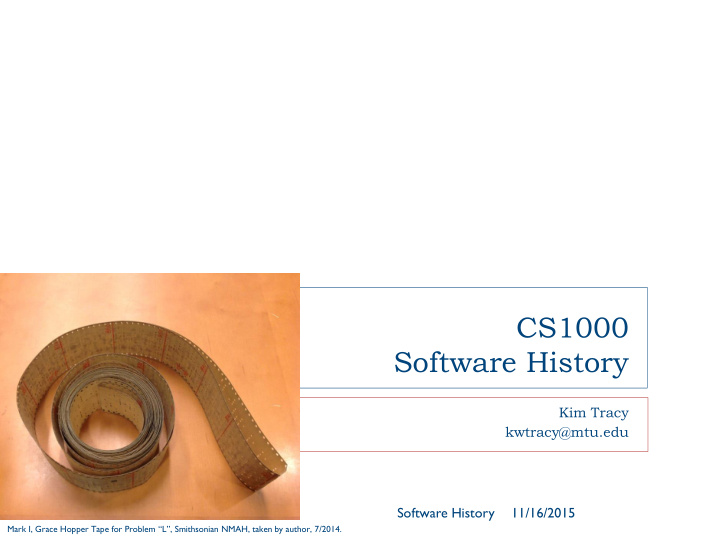



CS1000 Software History Kim Tracy kwtracy@mtu.edu 1 Software History 11/16/2015 Mark I, Grace Hopper Tape for Problem “L”, Smithsonian NMAH, taken by author, 7/2014.
Getting into computing. . . 2 Software History 11/16/2015
Experience Overview 3 KW Tracy - 2015
Software and Engineering Experience Broad experience Telecommunications software (5ESS, ISDN, etc.) Operating Systems development (R&D Unix) DBMS development (C RDBMS) Database application experience (Monsanto, Bell Labs) Information architecture Consulting Security Software System Tester Development methodologies, SW Quality AI Software Productization (Visualization, mapping, etc.) Consulting (Enterprise Architecture/Information Architecture) Network design and architecture Systems engineering 4 KW Tracy - 2015
IT Experience Across all IT areas (as CIO of NEIU) ERP (Enterprise Resource Planning) deployment IT Management ITIL – IT organization and processes Security IT Strategy, Applications, Operations and Infrastructure IT Roadmapping IT Consulting (reviewing other orgs, employment exam writing, security audit) Mobility application (3g/4g) Strategic application of IT – impact to business/organization 5 KW Tracy - 2015
Teaching Experience Taught in a wide variety of institutions and modalities NEIU, North Central College, IIT, DePaul, Lewis, and online Wide variety of courses taught (DBMS, A&D, Networking, OS, AI, Discrete Math, ToC, Prog. Langs & Compilers, eBusiness, Security, Open Source, MS Projects, etc.) Now at MTU, teaching SW Engineering and Systems courses Teaching Software History this summer (CS3090) Sidenote: the IBM 3090 was a popular mainframe. . . 6 KW Tracy - 2015
Software History-Why Book on software history Many current students have little knowledge of SW history Get dribs and drabs in some courses and textbooks Missing the big picture on software’s evolution There’s a need to know The focus is on what technology students need to know See: http://books.acm.org/subjects/forthcoming-titles for abstract. 7 Software History 11/16/2015
Outline – Software History Issues to address How did we get to the point where a history is needed? Historiographical approach Examples 8 Software History 11/16/2015
“Programming” the ENIAC Corbis Photo as in Forbes 9 Software History 11/16/2015
Issues Addressed No existing textbook on software technical history Students are left with a sea of bits and pieces My foci: Understanding software base and its evolution Applying learnings to future systems 10 Software History 11/16/2015
What has happened to make a software history necessary? To manage complexity, we’ve increased the levels of abstraction Students often learn and use only the highest levels We’re rarely teaching a lot of the lower levels (file systems, DBMS internals, OS internals, Assembler, etc.) We’ve rapidly specialized We’ve got over 60 years of history 11 Software History 11/16/2015 From CACM, “The Tears of Donald Knuth,” Jan. 2015, p.40
Historiographical method Software is a technology Using a “domain” and “sub - domain” approach* Focus on core domains: operating systems, programming environments, databases, networking, etc. Other concepts: significant events, communities of practice, standard engineering Importance of primary sources Software is an unusual technology Very loosely based on physical phenomena More like mathematics in building on previous abstractions/results Why haven’t historians of technology done this? * As per a combined approach of Basalla, Arthur and Constant. 12 Software History 11/16/2015
Software Taxonomy 13 Software History 11/16/2015
Influences to Software Change 14 Software History 11/16/2015
Book Structure Use a broad technical evolution with significant events and then include deep dives into: Chapters by software technology domain Important examples of source code Failures and learnings Other case studies 15 Software History 11/16/2015
Programmers’ Toolsets 16 Software History 11/16/2015
Influences on Toolset Evolution 17 Software History 11/16/2015
IBM 704 NASA, public domain 18 Software History 11/16/2015
Programmers’ Tools Over time 19 Software History 11/16/2015
Operating Systems 20 Software History 11/16/2015
High-level Evolution of Operating Systems 21 Software History 11/16/2015
Evolution of OS Features to Smaller Devices* * From Silberschatz , Galvin, and Gagne, Operating Systems, Concepts, 9 th Edition, Wiley, 2012, Chapter 20, Figure 1. 22 Software History 11/16/2015
Summary Software history’s time has come Student’s have a need to know No cohesive, digestible view Losing software pioneers Gives students a picture of the overall evolution of SW ability to reason about trends and future possibilities 23 Software History 11/16/2015
Questions? 24 Software History 11/16/2015
References Arthur, W. Brian, The Nature of Technology: What It Is and How It Evolves, Free Press, 2009. Basalla, George, The Evolution of Technology, Cambridge University Press, 1988. Constant II, Edward, The Origins of the Turbojet Revolution,The Johns Hopkins University Press, 1980. Mahoney, Michael, The Histories of Computing, Harvard University Press, 2011. Charles Babbage Institute (CBI), www.cbi.org. Computer History Museum, www.computerhistory.org Computer History Museum scanned manuals, http://www.bitsavers.org/ Various Oral histories CBI: http://www.cbi.umn.edu/oh/ CHM: http://www.computerhistory.org/collections/oralhistories/ Smithsonian Computer Oral History Collection, 1969-1973, 1977 http://dl.acm.org/citation.cfm?id=1234040 http://invention.smithsonian.org/downloads/fa_cohc_abstracts_a-d.pdf http://invention.smithsonian.org/downloads/fa_cohc_abstracts_e-g.pdf http://invention.smithsonian.org/downloads/fa_cohc_abstracts_h.pdf http://invention.smithsonian.org/downloads/fa_cohc_abstracts_i-m.pdf http://invention.smithsonian.org/downloads/fa_cohc_abstracts_n-r.pdf http://invention.smithsonian.org/downloads/fa_cohc_abstracts_s-z.pdf SIAM: The History of Numerical Analysis and Scientific Computing http://history.siam.org/oralhistories.htm History of Programming Languages I, II, and III conference proceedings, ACM. 25 Software History 11/16/2015
Recommend
More recommend